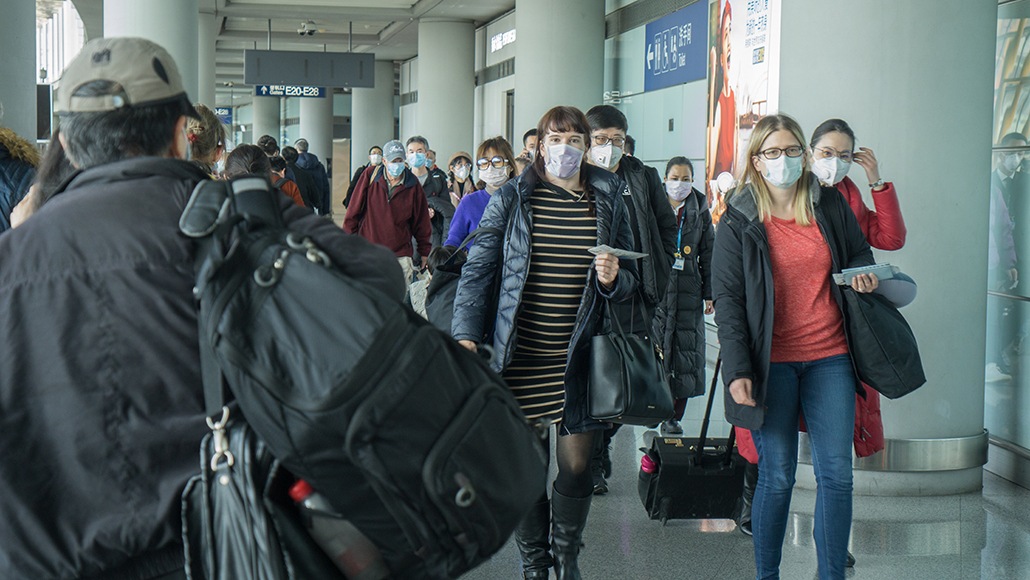What you need to know about the airborne transmission of COVID-19
Some scientists argue the virus can float in the air for extended lengths of time

The coronavirus can spread through the air, making mask-wearing and proper ventilation in crowded, indoor spaces like the Beijing Capital International Airport especially important for controlling the spread of COVID-19, experts say.
XiFotos/iStock Unreleased/Getty Images
The scientific debate over evidence that the coronavirus can float in the air for extended periods of time is intensifying.
The World Health Organization has repeatedly downplayed the importance of such airborne transmission, instead emphasizing, with substantial evidence, the risks of close contact with infected people.
But now, over 200 experts have signed an open letter to the WHO saying it’s time to recognize evidence that the coronavirus is airborne. The letter, published July 6 in Clinical Infectious Diseases, argues that the public health institution must update its prevention recommendations to help people avoid those risks.
“We acknowledge that there is emerging evidence in this field,” Benedetta Allegranzi, coordinator of WHO’s global infection prevention unit said July 7 in a news conference. “We have to be open to this evidence and understand its implications regarding the modes of transmission and also regarding the precautions that need to be taken.” The WHO plans to issue updated guidelines in the coming days
Here’s what you need to know about the ongoing debate and what it means for fighting the spread of COVID-19.
What is airborne transmission?
At the beginning of the outbreak, scientists thought that the virus was spread largely through bits of spit or mucus that people coughed or sneezed. Those droplets, up to roughly a millimeter across, would fall from the air within a short amount of time. The WHO has long maintained that the coronavirus spreads primarily via these larger droplets, which don’t easily travel farther than about six feet.
But researchers increasingly think that the coronavirus can stay in the air longer and travel farther in tinier bits, called aerosols, that can be generated by people talking, breathing or singing (SN:4/2/20).
These aerosols, which are less than 5 microns in diameter, can linger in the air for extended periods in places without ventilation, possibly infecting people long after the infected person has left.
What’s the evidence the virus is airborne?
Laboratory studies have found that infectious coronavirus can persist in the air for at least three hours when artificially aerosolized, though these results are hard to translate to real-world conditions. But evidence from “superspreader” events also point to airborne transmission. For example, a single infected person at a choir practice in Mount Vernon, Wash., infected at least 45 other people, many of whom were farther than six feet from the sick singer (SN: 4/17/20).
And one of the first outbreaks in Guangzhou, China was linked to a single positive case eating at a restaurant on January 24 (SN: 6/18/20). That person infected nine others that night, and an analysis of airflow patterns suggests that viruses were propelled as far as 20 feet by an air conditioning unit.
Scientists are still working out whether airborne transmission is a common feature of COVID-19’s spread, but evidence suggests it does happen.
Why does it matter?
The mode of transmission informs prevention strategies. The WHO has continually emphasized the importance of social distancing and handwashing to fight the spread of COVID-19. While still important, these measures are insufficient against an airborne virus, which can travel far in enclosed, poorly ventilated spaces. Masks may be necessary in such situations, even with proper social distancing.
The authors of the open letter implore the WHO to consider updating its recommendations to possibly include avoiding overcrowding in public buildings, properly ventilating indoor spaces and introducing germicidal ultraviolet light to air filtration systems to help mitigate airborne transmission. Even a simple open window might create enough ventilation to prevent an airborne coronavirus from infecting a new host.

Trustworthy journalism comes at a price.
Scientists and journalists share a core belief in questioning, observing and verifying to reach the truth. Science News reports on crucial research and discovery across science disciplines. We need your financial support to make it happen – every contribution makes a difference.







